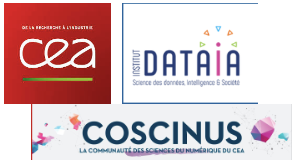Proposition de stage
-
Artificial Intelligence techniques for advanced modelling of accelerators
Barbara Dalena, Davide Faranda, Valérie GautardThe aim of the internship is to explore the possibility to use Artificial Intelligence (i.e. machine learning and Deep Learning Techniques) in order to predict the time evolution of the region of bounded motion in hadronic circular accelerators in presence of magnets imperfections. Numerical simulations are used to compute the stability region, called Dynamic Aperture (DA), from particles motion in the accelerator model. They can be time consuming, limiting the beam lifetime that can be simulated, above all for large hadronic circular accelerators like LHC.
Analytical models, based on Nekhoroshev theorem, exists to extrapolate the time evolution of DA [1].
The student will test the possibility to use Echo State Networks, employed successfully in the replication of chaotic attractors [2], to the prediction of the long term stability region in the case of future upgrade of LHC.
[1] A. Bazzani et al. “Advances on the modeling of the time evolution of dynamic aperture of hadron circular accelerators”, Phys. Rev. Acc. and Beams 22, 104003 (2019).
[2] J. Pathak et al. “Using Machine learning to replicate chaotic attractors, and calculate lyapunov exponent from data”, chaos 27, 121102 (2017).
- Machine learning techniques for chaotic systems
Valérie Gautard, Davide Faranda, Mathieu Vrac, Pascal Yiou
Chaos is an intrinsic component of many complex systems ranging from molecular dynamics to astronomy and atmospheric physics. In 1963 Lorenz [1] discovered that the behavior of a system becomes rapidly unpredictable because of the ignorance of its exact initial state. He proved that this holds true for the weather forecasts whose validity is theoretically limited to about 14 days [2].
However, in a series of recent papers [3,4 ], it has been shown that machine learning techniques can be used to extend the predictability of chaotic systems well beyond the predictability limit. This opens the possibility of improving weather forecast and the ability to describe the climate system.
The goal of this stage i) to reproduce with a suitable numerical code the results presented in [3] and [4] ii) to understand the limits of those techniques e.g. in reproducing extreme situations iii) to apply the method on climate data, namely the sea-level pressure fields over the North Atlantic for the period 1948-2018, issued from NCEP database, using as training set the first period of the available dataset and as verification the last part of the data. The candidate will then compare the capability of the method in reproducing the atmospheric dynamics with the error of ensemble weather forecasts [5].
The candidate will learn elements from dynamical systems theory as well as from climate dynamics. He/she will be in contact with climate as well as machine learning scientists.
[1] Lorenz, Edward N. "Deterministic nonperiodic flow." Journal of the atmospheric sciences 20.2 (1963): 130-141.
[2] Lorenz, Edward N. "The predictability of a flow which possesses many scales of motion." Tellus 21.3 (1969): 289-307.
[3] Pathak, Jaideep, et al. "Model-free prediction of large spatiotemporally chaotic systems from data: a reservoir computing approach." Physical review letters 120.2 (2018): 024102.
[4] Pathak, Jaideep, et al. "Using machine learning to replicate chaotic attractors and calculate Lyapunov exponents from data." Chaos: An Interdisciplinary Journal of Nonlinear Science 27.12 (2017): 121102.
[5] Faranda, Davide, Gabriele Messori, and Pascal Yiou. "Dynamical proxies of North Atlantic predictability and extremes." Scientific reports 7 (2017): 41278.
Proposition de thèse
- Artificial intelligence for a gamma-detector for high resolution pet imaging
Viatcheslav Sharyy (Viatcheslav.Sharyy@cea.fr), Dominique Yvon (Dominique.Yvon@cea.fr)
Positron emission tomography (PET) is a nuclear imaging technique widely used in oncology and neurobiological research. Decay of the radioactive tracer emits positrons, which annihilate in the nearby tissue and emits two back-to-back 511 keV photons. These photons are used to reconstruct the biological activity in the body.
The precise determination of the position of the positron annihilation vertex is important for an accurate image reconstruction with a good contrast. In particular, it is useful for neuroimaging studies of brain and for pre-clinical studies with animal models (rodents). The time-of-flight (TOF) technique is used to improve the signal-to-noise ratio in full body scans and therefore the image quality. This technique measures the difference in time between the two annihilation photons in addition to their position.
The ClearMind project at IRFU develops a novel detection technology, which combine the possibility to acquire images with a high spatial precision of several mm³ and time-of-flight capability with precision better than 50 ps (RMS).
To obtain these performances, it will be necessary to reconstruct properties of the interaction in the detector volume, from the data acquired on the surface. For this we work on artificial intelligence techniques (Neural Network, Deep Learning etc ...)
After that it is necessary to estimate the quality of images of a foreseen scanner based on our technology.
In this thesis, we propose, first, to work on the algorithms of artificial intelligence necessary for the event reconstruction in the detector, and then measure its performances. After that contribute to a Monté-Carlo simulation of the foreseen scanner and to the image reconstruction.

